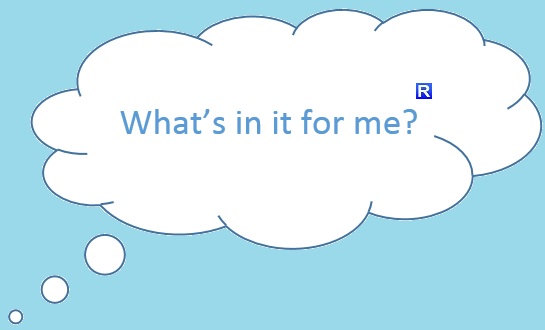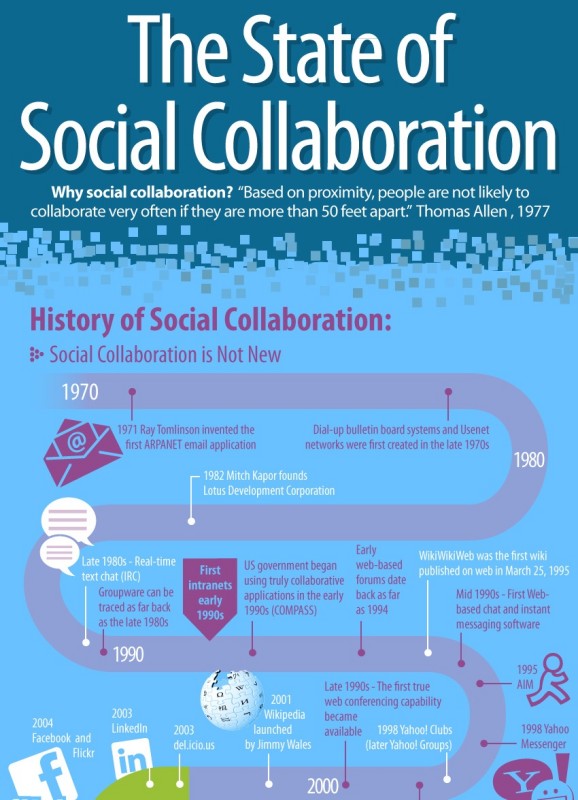What is collaboration and is it important in a corporate context?
Is collaboration relevant in a decision making context?
Does social collaboration foster creativity?
Does it create silos?
These are some of the questions that bubble up when the subject of social collaboration in a workplace is brought up with friends or colleagues. Conversations about collaboration normally tend to branch out beyond the confines of ‘social’ so I’ll structure it based on three pillars: Tools, Process and Data. But first, let us look at the history of social collaboration to contextualise.
Normally, when we are presented with a challenge like social collaboration to solve, we tend to think about the tools that exist in the market, for instance:
1) Microsoft’s sharepoint and Yammer.
2) IBM connections.
3) Jive social business platform.
4) Citrix Podio.
5) Cisco WebEx social.
6) Salesforce Chatter .. the list could go on.
Seeing that there are plenty of tools in the market, one would imagine – problem solved – yes?
Well, Gartner disagrees. Gartner predicts that 80% of Social business efforts won’t achieve intended benefits through 2015. Further, Gartner outlined two additional key predictions around social and collaboration:
By 2016, 50 percent of large organizations will have internal Facebook-like social networks, and that 30 percent of these will be considered as essential as email and telephones are today.
In 2017, the majority of all new user-facing applications will exhibit gamified-social-mobile fusion.
Exciting stuff, yes? But, will merely deploying one of the above tools in a corporate context foster collaboration between employees? One would imagine that the right technology enabler can boost workforce collaboration. Naturally, it would have to:
1) Collapse time space continuum (or effectively bring people together, virtually)
2) Build clear digital pathways that foster collaborative or group based outcomes
3) Make search easier; i.e; surface information to seekers faster.
The popular ‘assumptions’ after deploying a tool are:
1) We have a tool, so employees are using it.
2) It works for every employees’ job role.
3) All employees know how to use it best.
In my view, technology whilst being an important cog in the wheel is not the most definitive pillar. Basic collaborative culture, for instance take sharing knowledge or helping colleagues with a clarification – as a staffing manager, ask yourself; do role descriptions give staff time, freedom or recognition, are the decision making process inherently collaborative or are employees benefiting from sharing their ideas? This brings to the fore the need for a robust framework and process whereby there are:
1) Reward systems set up for collaborative behaviour.
2) Performance related KPIs encouraging employees to think about their own behaviour.
3) Training material available to those who are not naturally social media savvy and feel ‘out of the loop’.
An enterprise social network is intrinsically able to create public (both purely internal and including external – like clients) and private groups. Public groups, by definition is for content to be visible, accessible to everyone (and anyone). Equally, anyone can contribute and this is great because knowledge can come from a previously unknown source. As is human, there will be tendencies for corporate culture to get in the way; hence giving way to private groups. This is counter-productive, as instead of breaking down organizational silos, the social network ends up creating new ones. Now, if one of the objectives of social collaboration is to bring employees together and break-down silos, there probably should be a process to ensure that there are not too many private groups or if they do, they are necessitated by an organisational need.
That being said, doesn’t it all boil down to how well this question can be answered?

In my view, this is where gamification has a big part to play. Leaving employees with more than a sense of ‘good feeling’ because they helped another colleague is possible with game theory. To be more specific, a sense of achievement through scores and levelling-up can in turn, bring about further engagement and encourage newer users to join. The crux is that users are not only given the core incentive of sharing and increasing knowledge, but also given a chance to showcase how good they are at it. A classic real world example is Klout – some argue, a klout score is a measure of social media addiction as opposed to social media influence and that it can be easily ‘gamed’. After all, by definition, any game can be ‘gamed’ – it is all about whether you care enough to game or not.
Engagement data will enable technology enablers to assess which aspect of social collaboration are successful and which are not. to highlight an example from the agile methodology world – during an agile sprint retrospective, the focus is on ‘what went well’ and ‘what needs improvement’. Questions are driven forward with sprint data from a tool like Jira. Similarly, engagement data as well as a measure of user pulse when used to shape collaboration strategy could unlock more benefits for the business and at the same time answer the above question posted by users.
Watson and Crick, Penn and Teller, Marie and Pierre Curie, Abbot and Costello, Hewlett and Packard – if you haven’t gotten the point, two heads are better than one. More often that not, collaborators in business, science and arts have created concepts and formulated ideas that would not have happened alone. While working together is nothing new, when you are more than 50 feet away from each other, social media has made it possible to collaborate at an unprecedented scale and speed.
In your view which social collaboration tool, powered with gamification and a sound strategy, is proven by data to be the best at answering ”what’s in it for me?’
About Ravi Jay
Ravi is enthusiastic about all things Agile & Digital in service of building Products that people love to use. Welcomes a good chat on Conversational AI & Gamification. Talk to Ravi on Twitter @ravi_jay1 using #ThinkLookActDigital.

We use Yammer where I work and I find that it is very engaging. What you pointed out about silos are true and it sort of burst my bubble. However, I cannot agree more about the culture change that you recommend. It happened first before the tool was introduced. Good read.
Thanks Jerome. I posted a similar question on twitter this morning and the response has been rather inspiring. I’m posting the thread here if you’re keen to follow the conversation – https://twitter.com/Ravi_Jay1/status/500215737576062976
Not to take a tangent but your view on klout is interesting. I had not looked at it as addiction yet. Is there data to validate it?
I want to agree with the blog. Klout looks at quantity and I feel that quality is overlooked?
Interesting Conversation on twitter about #SocialCollaboration https://twitter.com/Ravi_Jay1/status/500221139332104195
Power, real power, comes in many forms. What you do when no one’s watching can indeed affect the world. Random acts of kindness prevail where pompous oversharing fails. True clout is what you get as others measure your actions and decide where they will repose their trust.http://www.forbes.com/sites/ciocentral/2012/04/18/clout-vs-klout-theyre-not-the-same-and-never-will-be/
My view is: ‘Time is #digital currency that you earn’. How a user’s attention is grabbed for longer periods of time could improve social sharing index. https://twitter.com/Ravi_Jay1/status/500571038129082368
Like this quote ‘Time is #digital currency that you earn’. What do you do with it?
Pingback: Social collaboration in a corporate context | S...